
4 Days in Foshan —— Where Kung Fu Legends Meet Culinary Artistry
From $1299/Person
This is a private 4-day cultural journey, designed for a minimum of four participants. Travel at a relaxed pace with exclusive access to curated experiences. The program includes accommodation in premium boutique hotels, dining at renowned local fine restaurants and private kitchens, and the comfort of a dedicated business vehicle throughout. All immersive activities—such as workshops, performances, and hands-on cultural classes—are guided by expert instructors, with all participation fees and private sessions fully included.
→ Click to Request a Quote
Journey Highlights:
If Guangzhou is the Millennium Commercial Capital, Foshan is the Millennium Craftsmanship Capital. This is the hometown of Wong Fei-hung, Ip Man, and Bruce Lee, and it is home to the true birthplace of Cantonese cuisine—Shunde. When you come to Foshan, you’re not just sightseeing; you're feeling a profound "Artisan Spirit": a spirit evident in every martial arts movement, every piece of Shiwan ceramic, and especially in every exquisite Shunde dish. If you want to grasp the essence of Kung Fu and Cantonese food, the answer is here.
I. Why Foshan Should Be Your Secret Spot?
The Source of Kung Fu: A Spirit Beyond the Movies
The whole world knows Bruce Lee and Ip Man, and their roots are right here. The Ancestral Temple (Zumiao) is more than just a Taoist temple; it’s a Museum of Martial Arts and Local Spirit. It embodies the pragmatic, resilient, and self-improving nature of Foshan people. When you step into Zumiao, you don't feel religion, you feel a culture defined by strength, balance, and mastery.
Shunde Cuisine: UNESCO-Certified Mastery
Guangzhou’s food is great, but Shunde is the next level. It has been designated a UNESCO City of Gastronomy, meaning its cuisine is considered an intangible cultural heritage. Chefs here don't rely on heavy seasoning; they focus on precision in knife skills, heat control, and delicate flavor layering. The Shunde philosophy is one of respect and deep understanding of the ingredients themselves.
II. Recommended Duration and Pace
Foshan and Shunde are typically visited after Guangzhou.
Minimum Requirement: 2 full days. Day one focuses on Foshan's Chancheng District (Zumiao, ceramics); day two is dedicated entirely to Shunde's cuisine and gardens.
Best Experience: 3 to 4 days. This allows you an extra day in Shunde to enjoy its slow pace and discover the private kitchens only locals know. Foshan is much slower than Guangzhou; it’s where you truly "find stillness."
III. Foshan Deep Dive: Experiencing the "Artisan Spirit"
Dimension One: The Bloodline of Kung Fu and the Power of Lingnan
Foshan is truly the "Home of Martial Arts," giving rise to styles like Hung Gar and Choy Li Fut, but the most compelling story is undoubtedly that of Wing Chun (詠春).
The Legend of Wing Chun Masters: Foshan is the heartland where Wing Chun matured. It was here that Grandmaster Ip Man taught and promoted this style, known for its simplicity, practicality, and centerline theory, which fundamentally changed the martial arts world. If you are curious about Wing Chun, the Ip Man Hall is a must-visit. It details the life of Grandmaster Ip Man and displays precious historical artifacts from his time in Foshan. You'll find that the legends you saw in the movies have historical backing here. The Ip Man Hall is the spiritual centerline of the Wing Chun philosophy..
The Spiritual Source of Bruce Lee: If you are a fan of international superstar Bruce Lee, you must know his roots. The Wing Chun he learned in Foshan during his youth became the philosophical foundation and source of power for his later creation, Jeet Kune Do. Coming here is tracing the starting point of a martial arts revolutionary.
Martial Arts Alive: Southern Lion Dance: The Lion Dance performances held daily in the Ancestral Temple square are far from simple theater. Foshan's style is the "Southern Lion Dance," characterized by its integration of martial arts footwork and stances, known for its high poles, leaping, and expressive movements. Watching the lion dance is witnessing a philosophical display of power and beauty, symbolizing good fortune, warding off evil, and the spirit of challenge.
Nanfeng Kiln: This is the "Living Capital of Ceramics." This ancient kiln has been firing for over 500 years without stopping. You can watch the masters turn clay into art with their bare hands, feeling the magic of fire and earth combined. The Kiln represents the "Civil" art, complementing the "Martial" art of Kung Fu.
Dimension Two: Shunde - The Precision Science on Your Tongue and Global Influence
In Shunde, forget everything you thought you knew about Chinese food, because this is the "West Point Military Academy" of Cantonese Cuisine.
Why Shunde is the World's Best? The designation as a UNESCO City of Gastronomy is no accident. The core philosophy is "Chefs Emerge from Fengcheng" (Shunde's old name). For centuries, Shunde chefs have been the backbone of global Cantonese restaurants, from Hong Kong to New York, London, and Vancouver. They exported Shunde's respect for ingredients, mastery of heat, and precision in flavor innovation, influencing most dishes you eat in Chinese restaurants overseas today.
The Ultimate Art of Fish: One Fish, Multiple Ways
Yu Sheng (Raw Fish Preparation): The pinnacle of Shunde cuisine. Chefs slice the fish so thin it's nearly translucent, served with a dozen condiments (ginger, peanuts, lemon leaves). This is not just eating raw fish; it's a cultural ritual testing knife skills, ingredient selection, and even water quality.
Sauna Fish / Fish Skin: The fillets are used for Yu Sheng, the bones and head for "Sauna Fish" (steamed rapidly over hot stones/steam), and the skin is used for Cold Tossed Fish Skin (crisp and bouncy). This shows the Shunde philosophy of "utilizing everything" and their absolute faith in "freshness."
Hot Dishes: The Symphony of Wok Hei and Heat Control
Roast Meats: The Perfect Blend of Crisp Skin and Juices: Shunde is the grandmaster of Cantonese Siu Mei (roast meats). Whether it's Roast Goose or BBQ Pork (Char Siu), the requirement is glass-crisp skin and incredibly juicy, flavorful meat inside. This demands artistic control over oven temperature and marination time.
Supreme Stir-fry (Xiao Chao Huang): The Crystallization of Speed and Aroma: Shunde stir-fries rely on "Wok Hei" (镬气), the soul of its cuisine. Chefs must use extremely high heat to stir-fry ingredients in mere seconds, creating that unique, smoky fragrance. Look for classic dishes like Stir-fried River Clams/Mussel Meat, which must be tender and powerfully fragrant.
Jun'an Steamed Pork: The Shock of Ancient Steaming: This is one of Shunde's most ceremonial dishes. A whole suckling pig is marinated and then slowly steamed for hours. It relies solely on steaming—not frying—resulting in incredibly tender meat and delicate skin. This is the ultimate centerpiece for local banquets.
The Gentle Revolution of Dairy: Desserts and Snacks
Double-Skin Milk (Shuang Pi Nai): This is Shunde's most demanding dessert, requiring strict control over time and temperature. It’s not a simple pudding; it needs two distinct layers of milk film, resulting in a smooth, sweet, and complex texture.
Stir-fried Milk (Chao Nai): Chefs use a Wok to quickly stir-fry buffalo milk with egg whites and starch until it solidifies. This dish tests the chef's millisecond control of heat, ensuring it is tender but not runny, smooth but not oily.
Ginger Milk Curd (Jiang Zhuang Nai): Another temperature-sensitive dessert, where ginger juice enzymes curdle the milk into a silky, custard-like texture. The flavor is spicy and sweet.
In summary: You need a full day in Shunde to experience this "respect for extreme craftsmanship." Every dish here, whether a grand hot plate or a delicate snack, is like a physics or math problem, requiring precise calculation and control.
Dimension Three: The Serenity of Lingnan Gardens
Qinghui Garden: One of Guangdong's Four Great Gardens, located in the heart of old Shunde. Originating in the Ming Dynasty, this garden is a masterpiece blending Lingnan and Jiangnan styles. Its architectural signature is the exquisite open-work leak windows. These windows allow light to filter through without revealing the full scene, creating a poetic, "half-hidden, half-revealed" atmosphere. The garden is rich in intricate wood carvings, brick carvings, and plaster sculptures, with every detail reflecting the refined taste and craftsmanship of the wealthy Lingnan literati.
Lingnan Tiandi: A revitalized commercial area built from old structures. It keeps the traditional "wok-ear houses" (distinctive rooflines), blue-brick paths, and old clan halls, but integrates modern cafes and shops. It’s like a "Lingnan Life Magazine Cover," allowing you to feel the essence of old Foshan in a comfortable setting.
Shunde Fisherman's Wharf: This is a modern leisure spot transformed from an old shipping industrial site. Here, old warehouses have become bars, cafes, and creative markets. Sitting by the river, enjoying Shunde nightlife, you'll feel the city's romantic and artistic slow pace, beyond its reputation for "craftsmanship."
IV: Insider's Private Tips
Transportation Secrets
Guangfo Metro: Foshan is conveniently connected to Guangzhou by metro—more flexible than the high-speed rail.
Shunde Transportation: Shunde's attractions are spread out; we recommend using taxis or ride-sharing services within the district.
Experience Tips
Showtimes/Lion Dance: The martial arts and Lion Dance performances at the Ancestral Temple are usually held at fixed times in the morning and afternoon. If you want to try a Lion Dance lesson, contact the Ancestral Temple or nearby martial arts schools beforehand.
Food Tasting: A Shunde food tour requires traveling with multiple people so you can sample more dishes, especially those large hot plates like the Jun'an Steamed Pork.
V. Conclusion
Friends, Foshan and Shunde are more than just two names in Cantonese culture. They represent the Chinese pursuit of "Mastery": martial artists seeking physical refinement, ceramic artists seeking the rebirth of clay, and chefs pursuing culinary precision.
Come to Foshan not to check a list, but to learn. You will leave with a profound respect for the "Artisan Spirit" and a completely new understanding of Cantonese cuisine philosophy.
If you’re ready, tell me: are you more interested in challenging "Kung Fu" or "Cuisine"? I'll design a personalized deep dive for you!

Walk Among Kung Fu Giants: Step onto hallowed ground at the Wong Fei-hung Memorial Hall and Ip Man Memorial Hall. Here, you'll delve into the lives and profound philosophies of these martial arts titans, truly feeling the powerful legacy of Foshan's kung fu heritage.

Master the Art of Wing Chun: This is your chance to personally experience Chinese martial arts. Participate in an exclusive Wing Chun lesson taught by a traditional master. Learn fundamental stances, punches, and defensive techniques, gaining a hands-on appreciation for the discipline and philosophy behind this world-renowned combat style.

Bruce Lee: Tracing the Dragon's Roots: Journey to Bruce Lee's Ancestral Home in Shunde's tranquil Jun'an town. This poignant visit offers a unique opportunity to connect with the personal history of the global superstar who forever changed martial arts and captivated audiences worldwide.

A Feast for the Senses: Shunde Cuisine: Prepare for an unforgettable culinary experience in the heart of the "World Capital of Gastronomy." Delight in Shunde's signature Cantonese dishes, including the famously flavorful Jun'an Steamed Pork, creamy Double-Layered Milk Pudding, and delightfully crispy Fried Milk. Each dish showcases Shunde's meticulous dedication to perfection, embodying the philosophy of "refined dining."
Idyllic Water Town Charms: Glide through the serene waterways of Fengjian Water Town, affectionately known as "Guangdong's Zhouzhuang." Experience the poetic beauty of its ancient bridges, flowing canals, and charming traditional homes. Then, wander through Bijiang Village, hailed as "Shunde's First Village," to discover its remarkably preserved ancient architecture, highlighted by the opulent Bijiang Golden House.



